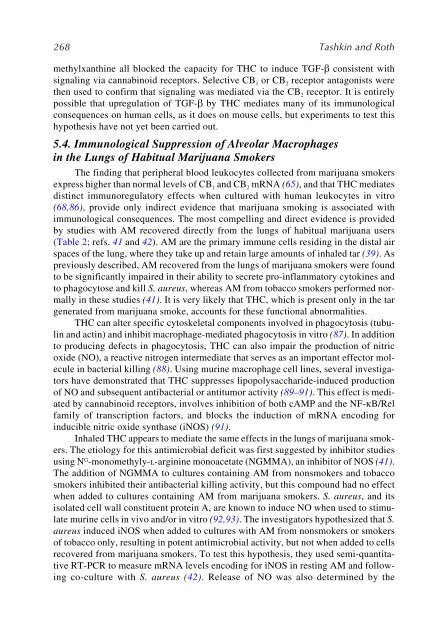Marijuana and the Cannabinoids
Marijuana and the Cannabinoids
Marijuana and the Cannabinoids
You also want an ePaper? Increase the reach of your titles
YUMPU automatically turns print PDFs into web optimized ePapers that Google loves.
268 Tashkin <strong>and</strong> Roth<br />
methylxanthine all blocked <strong>the</strong> capacity for THC to induce TGF-β consistent with<br />
signaling via cannabinoid receptors. Selective CB 1 or CB 2 receptor antagonists were<br />
<strong>the</strong>n used to confirm that signaling was mediated via <strong>the</strong> CB 2 receptor. It is entirely<br />
possible that upregulation of TGF-β by THC mediates many of its immunological<br />
consequences on human cells, as it does on mouse cells, but experiments to test this<br />
hypo<strong>the</strong>sis have not yet been carried out.<br />
5.4. Immunological Suppression of Alveolar Macrophages<br />
in <strong>the</strong> Lungs of Habitual <strong>Marijuana</strong> Smokers<br />
The finding that peripheral blood leukocytes collected from marijuana smokers<br />
express higher than normal levels of CB 1 <strong>and</strong> CB 2 mRNA (65), <strong>and</strong> that THC mediates<br />
distinct immunoregulatory effects when cultured with human leukocytes in vitro<br />
(68,86), provide only indirect evidence that marijuana smoking is associated with<br />
immunological consequences. The most compelling <strong>and</strong> direct evidence is provided<br />
by studies with AM recovered directly from <strong>the</strong> lungs of habitual marijuana users<br />
(Table 2; refs. 41 <strong>and</strong> 42). AM are <strong>the</strong> primary immune cells residing in <strong>the</strong> distal air<br />
spaces of <strong>the</strong> lung, where <strong>the</strong>y take up <strong>and</strong> retain large amounts of inhaled tar (39). As<br />
previously described, AM recovered from <strong>the</strong> lungs of marijuana smokers were found<br />
to be significantly impaired in <strong>the</strong>ir ability to secrete pro-inflammatory cytokines <strong>and</strong><br />
to phagocytose <strong>and</strong> kill S. aureus, whereas AM from tobacco smokers performed normally<br />
in <strong>the</strong>se studies (41). It is very likely that THC, which is present only in <strong>the</strong> tar<br />
generated from marijuana smoke, accounts for <strong>the</strong>se functional abnormalities.<br />
THC can alter specific cytoskeletal components involved in phagocytosis (tubulin<br />
<strong>and</strong> actin) <strong>and</strong> inhibit macrophage-mediated phagocytosis in vitro (87). In addition<br />
to producing defects in phagocytosis, THC can also impair <strong>the</strong> production of nitric<br />
oxide (NO), a reactive nitrogen intermediate that serves as an important effector molecule<br />
in bacterial killing (88). Using murine macrophage cell lines, several investigators<br />
have demonstrated that THC suppresses lipopolysaccharide-induced production<br />
of NO <strong>and</strong> subsequent antibacterial or antitumor activity (89–91). This effect is mediated<br />
by cannabinoid receptors, involves inhibition of both cAMP <strong>and</strong> <strong>the</strong> NF-κB/Rel<br />
family of transcription factors, <strong>and</strong> blocks <strong>the</strong> induction of mRNA encoding for<br />
inducible nitric oxide synthase (iNOS) (91).<br />
Inhaled THC appears to mediate <strong>the</strong> same effects in <strong>the</strong> lungs of marijuana smokers.<br />
The etiology for this antimicrobial deficit was first suggested by inhibitor studies<br />
using N G -monomethyly-L-arginine monoacetate (NGMMA), an inhibitor of NOS (41).<br />
The addition of NGMMA to cultures containing AM from nonsmokers <strong>and</strong> tobacco<br />
smokers inhibited <strong>the</strong>ir antibacterial killing activity, but this compound had no effect<br />
when added to cultures containing AM from marijuana smokers. S. aureus, <strong>and</strong> its<br />
isolated cell wall constituent protein A, are known to induce NO when used to stimulate<br />
murine cells in vivo <strong>and</strong>/or in vitro (92,93). The investigators hypo<strong>the</strong>sized that S.<br />
aureus induced iNOS when added to cultures with AM from nonsmokers or smokers<br />
of tobacco only, resulting in potent antimicrobial activity, but not when added to cells<br />
recovered from marijuana smokers. To test this hypo<strong>the</strong>sis, <strong>the</strong>y used semi-quantitative<br />
RT-PCR to measure mRNA levels encoding for iNOS in resting AM <strong>and</strong> following<br />
co-culture with S. aureus (42). Release of NO was also determined by <strong>the</strong>


